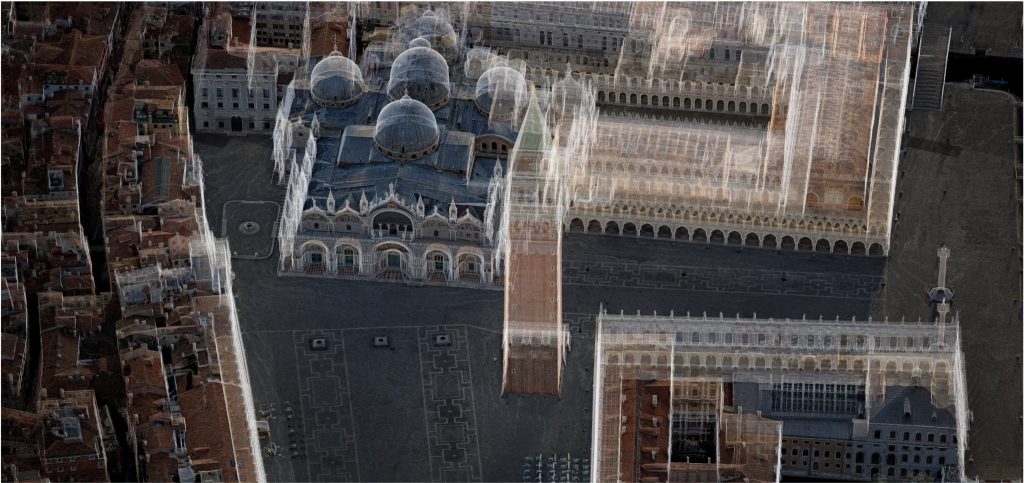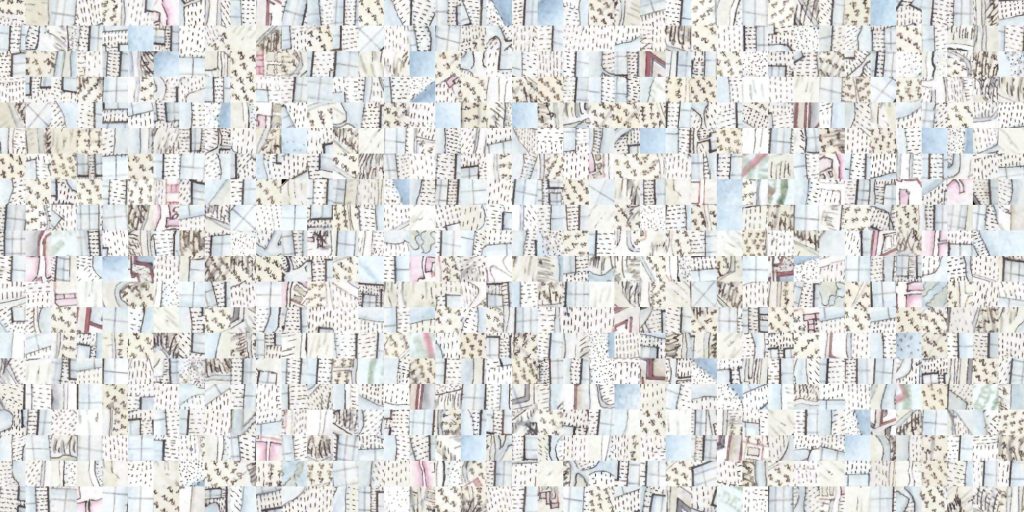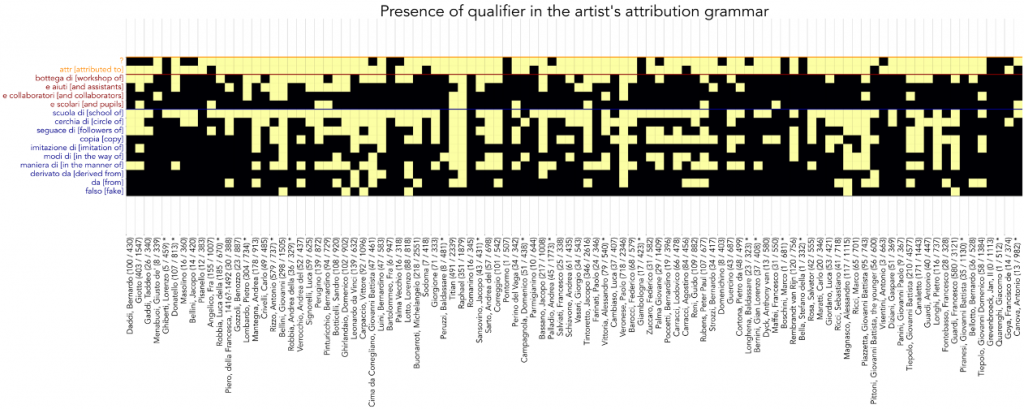The Origins of Venice
Type : MSc Semester project
Sections concerned : Digital humanities, Data science, Computer science, Environmental Sciences & Engineering
The origins of Venetian settlement are still partially unknown. A small segment of historiography has tried to reconstruct the cartography and urban structure of Venice in 1100 and 1360.
The aim of the project is to create, for the first time and based on these historiographical sources processed through OCR, the digital urban atlas of Venice for the years 1100 and 1350, and to use it as a source for analyzing owners and land uses.
The final goal is to produce an interactive cartography (e.g. Leaflet) covering the 12th and 14th centuries. Further statistical analysis of ownership, land uses and family names are part of the project.
The resulting dataset will be shared online in the Parcels of Venice interface and analyses have the potential to be published in a scientific journal.
Keywords: Venice Time Machine, Digital Urban History, OCR
Prerequisites: Python programming, basics of JavaScript (optional)
Contact : [email protected]

Cartonomics / Visual semiotics I
Type : MSc Master thesis, MSc Semester project
Sections concerned : Digital humanities
Cartonomics is a project developed by the Time Machine Unit with the aim to identify and extract the visual elements (symbolic and representational) that constitute the figurative language of cartography. This innovative research is based on the largest map corpus ever studied in the Digital Humanities and the History of Cartography.
The aim of the project ‘Visual semiotics’ is to produce a granular exploration of cartographic semantic. Some of the questions the project seeks to answer are : what is the evolutionary history of the representation of specific features, such as relief, and elevation, through the ages? How are these conventions affected by the presence of specific terrains, such as buildings or water, and how is that related to the historical measurement techniques? How is the natural landscape treated by the means of symbols and icons? The project will deploy deep learning technologies and statistical approach to anwer some of these questions.
Keywords: Visual computing, Computational semiotics, Visual languages, Semantic segmentation
Prerequisites: –
Contact : [email protected]

The Hidden Grammar of Art History
Type : MSc Semester project, BSc Semester project
Sections concerned : Digital humanities, Data Science, Computer Science
Analyzing the taxonomy of author’s name in art history is a key element in understanding artistic dynamics. Some artists have enjoyed great fortunes through the centuries as their works were widely copied; others operated thriving workshops, indicative of large-scale production for a potentially open and much larger market. Over the years, in the context of the Replica project, we have digitized 300,000 cardboards with images of art historical objects. Each cardboard is accompanied by relevant digitised metadata. In this dataset a specific field is the «name of the artist» that is articulated with a specific grammar. Early research results have already shown that analyzing taxonomy is a new and potentially very promising field for deriving a new theory of artistic practice between 1300 and 1900. The goal of the project is to work with the OCR we have extracted, accomplishing a realignment of entities and deriving some heuristics from it. An associated paper will be published as part of the project.
Keywords: Digital Art History, Authorship, Entities disambiguation, Data integration
Prerequisites: Python
Contact : [email protected]

Door-to-door
Type : MSc Master thesis, MSc Semester project
Sections concerned : Digital humanities, Humanités numériques (UNIL), Histoire (UNIL)
The city directories (contemporary yellow pages) first appeared in England and France in the second half of the 17th century, as lists of business addresses or addresses of important people, for the use of travelers, foreigners, or as a publication to validate the monumental importance of certain city places or homes of famous people. Directories are an exceptionally rich source for historical research, giving information on a more frequent basis than census data, and they list not only the taxable population in the Ancien Régime, (mostly male household head), but also represent a broader social corpus, especially women. In some cases, the information on commercial and professional activities have been recognized as the most significant source. The goal of the project is to conduct analyses on a 10-year sample corpus for Lausanne. This analysis can be followed by a comparative analysis of three cities: Lausanne (agricultural city), Paris (European capital city), and New York (cosmopolitan city) in the same year, 1880. The datasets of Paris and New York are already extracted. The project will entail extraction of the Lausanne sample through OCR. The aim is to understand the specific signature of each city by analyzing the trades first individually, and then comparatively. Datasets will be published online and potentially interesting results might be discussed in a paper.
Keywords: Document processing, OCR, Layout analysis, Digital Urban History
Prerequisites: Python
Contact : [email protected]

Lausanne 1727
Type : MSc Semester project, BSc Semester Project
Sections concerned : Digital humanities, Data Science, Environmental Sciences & Engineering
The creation of the Melotte cadastre in Lausanne began in 1721 and concluded in 1727. This positions it as one of the oldest geometrical cadastral plans in both Europe and the world. While Lausanne had been previously mapped in a schematic cadastre in the 17th century, the Melotte cadastre marks the city’s first geometric survey. This document captures the state of Lausanne during the Enlightenment, including its surroundings, and holds significant historical value in the fields of urban history and cartography due to its age.
The Melotte plates have been georeferenced and automatically extracted. The first objective of this project involves recovering the information on land use and land ownership, based on the source image. The historical geodata will then be used as a source to analyze and describe the landscape of Lausanne in the 18th century, focusing on the integration of the city with its rurality. During this project you will learn to work with GIS software and deploy spatial environmental analyses.
Keywords: Environmental History, Digital Urban History, GIS
Prerequisites: –
Contact : [email protected]

Past projects
Bachelor Project (CS)
Cultural evolution can be modelled as an ensemble of ideas, and conventions, that spread from one mind to another. This is referred to as memes, elementary replicators of culture inspired by the concept of a gene. A meme can be a tune, a catch-phrase, or an architectural detail, for instance. If we take the example of maps, a meme can be expressed in the choice of a certain texture, a colour, or a symbol, to represent the environment. Thus, memes spread from one cartographer to another, through time and space, and can be used to study cultural evolution. With the help of computer vision, it is now possible to track those memes, by finding replicated visual elements through large datasets of digitised historical maps.
By extracting visual elements from tens of thousands of maps and embedding these elements in a feature space, it becomes possible to estimate which elements correspond to the same replicated visual idea, or meme. This opens up new ways to understand how ideas and technologies spread across time and space.
Despite the immense potential that such data holds for better understanding cultural evolution, it remains difficult to interpret, since it involves tens of thousands memes, corresponding to millions of visual elements. Somewhat like genomics research, it is now becoming essential to develop a microscope to observe memetic interactions more closely.
In this project, the student will tackle the challenge of designing and building a prototype interface for the exploration of the memes on the basis of replicated visual elements. The scientific challenge is to create a design that reflects the layered and interconnected nature of the data, composed of visual elements, maps, and larger sets. The student will develop its project by working with digital embeddings of replicated visual elements, and digitised images in IIIF framework. The interface will make use of the metadata to visualise how time, space, as well as the development of new technologies influence cartographic figuration, by filtering the visual elements. Finally, to reflect the multi-layered nature of the data, the design must be transparent and provide the ability to switch between visual elements and their original maps.
The project will draw on an exceptional dataset of tens of thousands of American, French, German, Dutch, and Swiss maps published between 1500 and 1950. Depending on the student’s interests, an interesting case study to demonstrate the benefits of the interface could be to investigate the impact of the invention of lithography, a revolutionary technology from the end of the 18th century, on the development of modern cartographic representations
Semester project (Master, CS)
From 1812 onwards, land mapping campaigns were launched throughout Europe on the model of the so-called “Napoleonic” and later “renovated” cadastre. These maps covered the largest part of Western Europe, from Spain to the Netherlands, including Italy, the Austro-Hungarian Empire and the Confederation of the Rhine (Germany). The Napoleonic cadastre is thus one of the main historical sources of the 19th century and the hundreds of thousands of sheets that compose it are largely digitized. Georeferencing, i.e. spatial recalibration of the cadastral sheets, would constitute a fantastic added value for urban planning and environmental sciences by allowing large-scale studies on two centuries of territorial evolution. Within the framework of this project, the student will develop automatic methods based on computer vision techniques and graph neural networks to automate the realignment of cadastral sheets.
Master thesis (Unil, DH)
The Polier notebooks are a set of handwritten documents written by Jean-Henri Polier de Vernand (1715-1791), lieutenant baillival of Lausanne, under the title Livre de Raison, soit Memorial Universel. These notebooks, which total nearly 26,300 pages written between 1754 and 1791, are a precise account of the daily life of the time and of the micro-history of Lausanne. They contain a great deal of information about the economic and social history and details of daily life, such as trade or meteorology. The project aims at automatically transcribing the Polier notebooks using state-of-the-art automatic handwriting recognition (HTR) methods in order to finally unravel the mysteries of these pages. In a second step, an investigation based on distant reading and natural language processing (NLP) technologies will allow to deepen a research question on the themes of environmental, social, or economic history.
Master thesis (DH) + Semester project (Bachelor, Maths)
The Bibliothèque Historique de la Ville de Paris digitised more than 700 maps covering in detail the evolution of the city from 1836 (plan Jacoubet) to 1900, including the famous Atlases. They are of a particular interest in the urban studies of Paris, which was at the time heavily transfigured by Haussmanian transformations. For administrative and political reasons, the City of Paris did not benefit from the large cadastration campaigns that occurred throughout Napoleonic Europe at the beginning of the 19th century. Therefore the Atlas’s sheets are the finest source of information available on the city over the 19th century. In order to make use of the great potential of this dataset, the information contained in the maps must be converted from its visual representation to an abstract, geometrical, form, on which to base quantitative studies. This conversion from an input raster to an output vector geometry is typically well-performed by combining Convolutional Neural Networks for pixelwise classification to standard computer vision techniques. In a second time, the student will develop quantitative techniques to investigate the transformation of the urban fabric.
Semester project (Master, CS)
At the end of the 19th century, a global will for administrative reform brought about the need to renovate the old cadastres dating from the Napoleonic era. Cadastral campaigns of cities and territories were launched by applying the best technologies of the time. The canton of Vaud took part in the movement and published in 1888 the renovated cadastre of Lausanne, a collection of more than 300 plates of high graphic quality and remarkable accuracy. It includes a complete legend that includes the use of each parcel (house, café, bakery, field, vineyard, etc.) and the owner. The automatic vectorization project aims to use state-of-the-art technologies developed in the framework of the Time Machine initiative to transform the historical images into vector maps using CNN-based semantic segmentation. For the legend, automatic document processing and handwritten text recognition (HTR) methods could also be deployed. This work would pave the way to a better understanding of a key period of Lausanne’s history that saw the birth of the city we know today. The vectorization of the document will also open new avenues of investigation for the student to explore the palimpsest of Lausanne’s history.
Semester project (Master, CS)
The Historical Museum of Lausanne has a collection of more than 38’500 digitized images, including numerous shots of Lausanne and photographs of buildings. These archives are the keystone of the historical reconstruction of the city because they constitute a direct trace of the light of the past. In this project, the student will develop automatic methods based on photogrammetry and neural networks to match the images and infer the angle and position of the photographic shot. This work will open the possibility of directly reprojecting historical photographs onto 4D models.
Other projects
Do not hesitate to contact us to discuss your own project ideas on a specific document or theme.